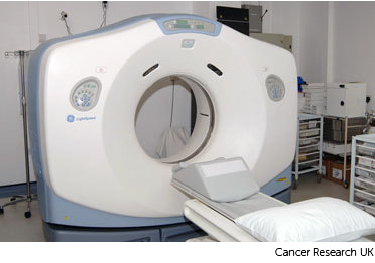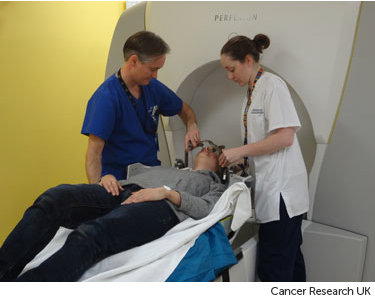Planning radiotherapy for brain tumours
The radiotherapy team plans your radiotherapy before you start treatment. This means working out the dose of radiotherapy you need and exactly where you need it. Your planning appointment takes from 15 minutes to 2 hours.
For a brain tumour, you usually have a planning CT scan and the radiotherapy team make a mask to keep your head still.
The planning CT scan
You usually have a planning CT scan in the radiotherapy department. The scan shows the cancer and the area around it. You might have other types of scans to help your treatment team plan your radiotherapy. The plan they create is just for you.

Your radiographers (sometimes called radiotherapists) tell you what is going to happen. They help you into position on the scan couch. You might have a type of firm cushion called a vacbag to help you keep still.
The CT scanner couch is the same type of bed that you lie on for your treatment sessions. You need to lie very still. Tell your radiographers if you aren't comfortable.
Injection of dye
You might need an injection of contrast into a vein in your hand. This is a dye that helps body tissues show up more clearly on the scan.
Before you have the contrast, your radiographer asks you about any medical conditions or allergies. Some people are allergic to the contrast.
Having the scan
Once you are in position your radiographers move the couch up and through the scanner. They then leave the room and the scan starts.
The scan takes about 5 minutes. You won't feel anything. Your radiographers can see and hear you from the CT control area where they operate the scanner.
Keeping your head still
You need to keep your head still during radiotherapy. This is called immobilisation. You might have one of the following:
- mask or mould
- head frame
Radiotherapy mask (mould)
A radiotherapy mask is also called a shell. It keeps your head still each time you have your radiotherapy. So your treatment is as accurate as possible.
You can see through most types of masks, as they usually have lots of small holes. The radiographers might make marks on them. They use the marks to accurately line up the radiotherapy machine for each treatment.
Your team might make the mask in the mould room of the radiotherapy department or during your CT planning session. It takes between 10 to 45 minutes depending on the type of mask.
Before making the mask
The mask is normally made directly against your skin. It's helpful to wear clothing that you can easily take off from around your neck. You also need to take off any jewellery from that area.
Having a lot of facial hair can make it difficult to make a head mask. The radiotherapy staff will tell you about any hair issues at your planning session.
Making the mask
A mould technician or radiographer uses a special kind of plastic that they heat in warm water. This makes it soft and pliable. They put the plastic on to your face so that it moulds exactly. It feels a little like a warm flannel and is a mesh with holes in so you can breathe.
After a few minutes the mesh gets hard. The technician takes the mask off and it is ready to use.
The mask is kept in the radiotherapy department and you wear it for each treatment. Or you might have a mask made for a single treatment.
The video below shows what happens when you have your mesh mask made. The video is about 1 and a half minutes long.
Voiceover: Making a mesh mask for radiotherapy takes a few minutes.
Radiographer: I am just going to heat this up now if you just keep nice and still there and just want to close your eyes for us.
Voiceover: The radiographer softens the mask by putting it in warm water for a minute or two. When the radiographer puts the mask on to your face it will feel warm and damp. They then clip it to the bed that you are lying on. It takes a minute or two to dry into the shape of your face. The radiographers will mark the mask where the light lines are.
Radiographer: Okay, you are just going to feel us pressing down on the mask there; you are doing really well are you still okay?
Patient: Mmm...
Voiceover: They use the marks on the mask to line up the machine each time you have treatment. The mask keeps you head still and makes sure that your treatment is directed at the cancer. They put your name on the mask and keep it in the radiotherapy department ready for your treatment.
Patient: They um told me about the procedure, a mask being fitted, uumm that it would be moulded to the shape of my face. Umm which they did, three lovely girls umm put my mind at ease, sat me down, heated the mask, moulded it around my face, um not an uncomfortable thing at all to go through.
Head frame
Your radiotherapy team might fit a head frame if you are going to have treatment from a GammaKnife machine. They usually fit the frame on the same day as your radiotherapy treatment.
They attach the head frame to your skull using 4 pins. Before they attach it, you have 4 injections of local anaesthetic at the points where the frame attaches to your head. This takes about 10 minutes. The head frame is then fixed into the radiotherapy machine while you are lying on the treatment couch.
As they fit the frame, you feel some pressure and tightness, but it usually feels better within a few minutes. You then have your radiotherapy treatment on the same day.


You usually have a head frame fitted for a single treatment or a small number of treatments. If you are going to have a number of treatments, you have the frame fitted and removed each time.
After your planning session
You might have to wait a few days or up to 3 weeks before you start treatment.
During this time the physicists and your radiotherapy doctor (clinical oncologist) decide the final details of your radiotherapy plan. They make sure that the area of the cancer will receive a high dose and nearby areas receive a low dose. This reduces the side effects you might get during and after treatment.
Before you start your radiotherapy
You usually have your radiotherapy as an outpatient. This means that you go to hospital every day, but you don't stay overnight. These visits can disrupt your day. So it’s worth sorting out a few things before you start treatment. These might include:
- work
- care for children or other loved ones
- care for your pets



